Opening the Furo: Tsumami
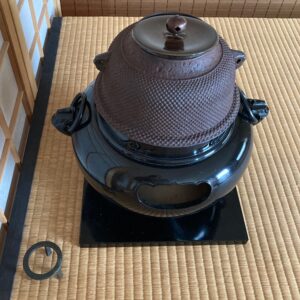
In the realm of Chanoyu, water for tea is heated in a kama, 釜, kettle, placed over a fire. The fire is usually made with sumi, 炭, charcoal. According to Japanese domestic tradition, a fire is kept in an i-ro-ri, 囲炉裏, enclose-hearth-inner, which is a hearth set in the floor where a kettle of water is continually maintained. This confines the fire to a fixed place, making it impossible to prepare tea away from the fire. That issue is resolved by the use of an ancient, portable hearth, such as the familiar hi-bachi, 火鉢, fire-bowl, which is moved and placed anywhere heat is needed.
The furo can be used throughout the year to make Tea, however, in Chanoyu, the sunken hearth, ro, 炉, which is a permanent fixture in Tea rooms, can be opened and used during the cold half of the year. Sometime around early November, the furo is put away, and the ro is opened, which is called ro fu-ro ire kae, 炉/風炉入れ替え, hearth/wind-hearth into exchange. In turn, around the beginning of May, the ro is no longer needed for extra warmth, the ro is covered over, the the furo is returned to the Tearoom, which is called fu-ro ro ire kae, 風炉/炉入れ替え, wind-hearth/hearth into exchange.
Formal Chanoyu had been presented in Buddhist temples, first as a healthful benefit offered to Buddhist deities, and shared by the clergy. This was particularly associated with Zen Buddhism, as both Zen and Tea were brought from China by Ei-sai Zen-shi, 栄西禅師, Splendor-west Zen-master, Japanese Buddhist who studied in China during the 12th century. As the sunken hearth is not a part of Buddhist worship halls, a suitable, refined, portable brazier was needed, which was manifest in the fu-ro, 風炉, wind-hearth. Wind, fu, kaze, 風, is just air until it moves, which may be the origin of the word ‘wind’-hearth because it is moveable.
In China during the Sō-ji-dai, 宋時代, Dwell-time-generation, (960 – 1279), Buddhist temples had altars where various implements were displayed. The implements were comprised of a central kō-ro, 香炉, incense-hearth, placed in the middle in front of the image of a Buddha, and flanked by a ka-bin, 花瓶, flower-bottle, filled with water, and a rō-soku-tate, 蝋燭立, wax-lamp-stand, candlestick. Quite often the implements called san-gu-soku, 三具足, three-too-leg, were in forms based on the lotus, hasu, 蓮, which is sacred to Buddhism. In more formal altar settings, there are five implements, and are called go-gu-soku, 五具足, five-tool-foot, which has the kōro in the middle, with a pair of flower containers and a pair of candlesticks.
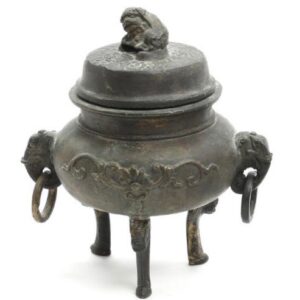
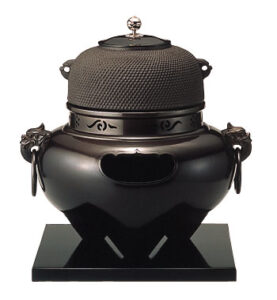
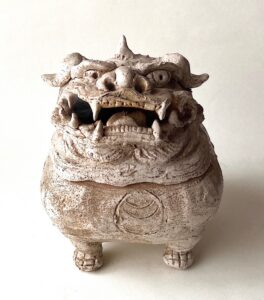
Kō-ro, 香炉, incense-hearth, in the form of ding, 鼎, cauldron, with elephant head lugs for the rings and a lion-form knob on the lid, Sō-ji-dai, 宋時代, Dwell-time-generation, 960 – 1279.
Ki-men bu-ro, 鬼面風炉, Demon-face wind-hearth, bronze with iron kama, 釜, kettle.
Kō-ro, 香炉, incense-hearth, ceramic, covered container in the form of a Kara-ji-shi, 唐獅子, Tang-lion-of, Shi-no yaki, 志野焼, Aspire-field fired, by Mae–kawa Den-kō, 前川電光, Fore-river Lightning-light, Se-to Shi, 瀬戸市, Rapids-gate City. Note the line depiction of a hō-ju, 宝珠, treasure-jewel, which is likened to the knob of the lid of the kama of the furo.
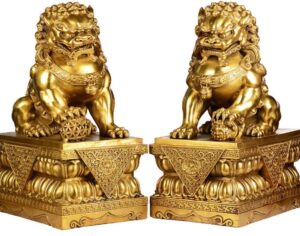
Modeled after the Chinese imperial guardian lions, this foo dog pair has amazing details and vivid expressions. The male has his right paw on an embroidered ball and the female has a playful baby cub on its back under her left paw. It is believed that they keep away the evil spirits.
The symbolic ball, protects the world, the earth, while the female, with a paw on a cub, which is often depicted on its back, protects the dwelling, household, represents the element of spirit. The Chinese lion figures are on rectangular plinths, just as the fu-ro, wind-hearth, is on a square shiki-ita, 敷板, spread-board, and the sunken hearth is square with a wooden ro-buchi, 炉縁, hearth-frame.
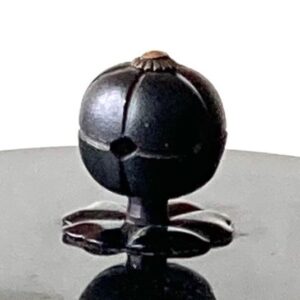
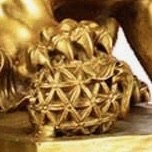
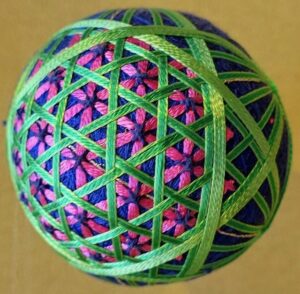
Tsumami, 摘み, pinch, knob of kama futa, 釜蓋, kettle lid, bronze, sphere in the form of ume no hana, 梅の花, Japanese apricot’s flower. Latticed ball under a lion’s right paw. Te-mari, 手毬, hand-ball, wrapped with a multitude of colored threads; these personally crafted toys originated in China and arrived in Japan in the 7th century, and became a much honored craft.
Each of the lions has one of its paws on an object, which causes the creature to have three paws / feet touching the surface. This is in the manner of incense burners that have three feet.
The spherical knob called a tsumami, 摘み, pinch, of the lid of the kama, is always taken with the thumb and forefinger of the right hand, emulating the male lion in touch with the world. Whether the ‘lion’ represents a child of the Dragon King, the ball may be identified with the hō-ju, 宝珠, treasure-jewel, the ‘flaming pearl of enlightenment’ that are sought by dragons. Ryū-sei Kyū-ji, 竜生九子, Dragon-born Nine-child.
The pair of lions are placed on either side of an entrance, with their faces directed away from the entrance. Facing the pair, the female lion with the infant is on the right side, which is In, 陰, Yin, and the male lion with the ball is on the left side, which is Yō, 陽, Yang.
The Chinese lion in Chinese is shi, 獅, lion, in Japanese, shi-shi, 獅子, lion-of, guardian animals in Japan called Kara-ji-shi, 唐獅子, Tang (Chinese)-lion-of. The other guardian animal is the Koma-inu, 狛犬, ‘ancient part of Korea’-dog. These sources have caused non-Asians to call these guardian creatures, lions, and dogs. It is also likely that to traditional Chinese people the animals are children of the Dragon King.
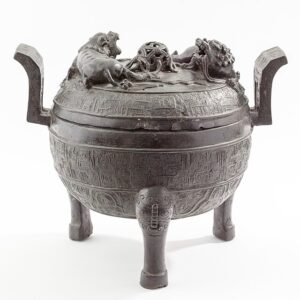
The Chinese ding, 鼎, cauldron, is one of the many so-called ‘ritual bronzes’ in China. The illustrated vessel is round with three legs, and there are other vessel types that are square with four legs. The bowl has its own tripod, and like three-legged cooking vessels, is put directly into the wood/charcoal fire. The relief details of the domed lid depict a pair of reclining lions with a treasured lattice ball in the center of the lid.
From ancient times in China, a pair of lions acted as guardians to the imperial palace in China. The male lion with his right paw on a sphere that is symbolic of the world, and the female lion with her left paw on an infant lion, or some other object. These creatures have found their way all throughout Asia at temples, shrines, government buildings, and at homes, etc. A creature that appears to be a lion may actually be one of the children of the Dragon King. Chinese dragons, also found in Japan, vie to get a hō-ju, 宝珠, treasure-jewel, the wish-granting gem, which may be likened in form of the ball held by the lion.
As a prototype of the Japanese Chanoyu furo, the ding vessel could become the container for ashes and a charcoal fire, the lid substituted by a separate vessel for hot water. In a sense it could be that the lid of the ding is itself a container, perhaps to serve food cooked in the ding itself, This is true with many other Chinese vessels, where the lid is used as a serving bowl. This would be in accord with the ding’s lion’s ball becomes a knob or tsumami, 摘み, pinch, to lift the lid, just as the tsumami of the lid of the kama of the furo.
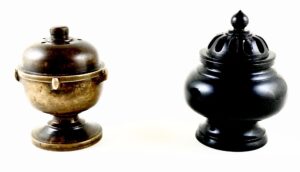
Futa-oki, 蓋置, lid-place, with invertible perforated lid, bronze, in the form of ho-ya gō-ro, 火舎香炉, fire-house incense-hearth; full height, 1.8 sun kujira-jaku, by Kana-tani Sō-rin, 金谷宗林, Gold-valley Sect-grove: made for use in Chanoyu.
Ho-ya gō-ro, 火舎香炉, fire-house incense-hearth, with removeable perforated lid, black-patinated bronze; without lid H. 1.8 sun kujira-jaku: made for burning incense on a Buddhist altar.
The kama, 釜, kettle, may represent a lion head. The lid of the kama is rested on a futa-oki, 蓋置, lid-place, which is often inverted. For example, the top of the hoya gōro is turned over, which may evoke the image of the infant lion lying on its back. The hoya is the hō-ju, 宝珠, treasure-jewel, likened to the lion’s ball, and the infant lion curled up like sphere.
The go-toku, 五徳, five-virtue, as a futaoki, has its ring upright, but has its three feet up when supporting a kama, kettle. Hoya futaoki has 5 or 6 talons on the lower hemisphere to secure the lid. Buddhist hoya may not have talons. Talons mean dragon claws.
The lids of the hoya and the hoya futaoki are both perforated to allow smoke and fragrance to pass through the openings. A parallel can be found in the lid of the kama, which is left somewhat ajar to allow steam and air pressure to pass though the opening. An open vessel has aspects of In, 陰, Yin, negative, whereas a closed vessel has aspects of Yō, 陽, Yang-positive.
For Further study, see also: Go-gatsu

